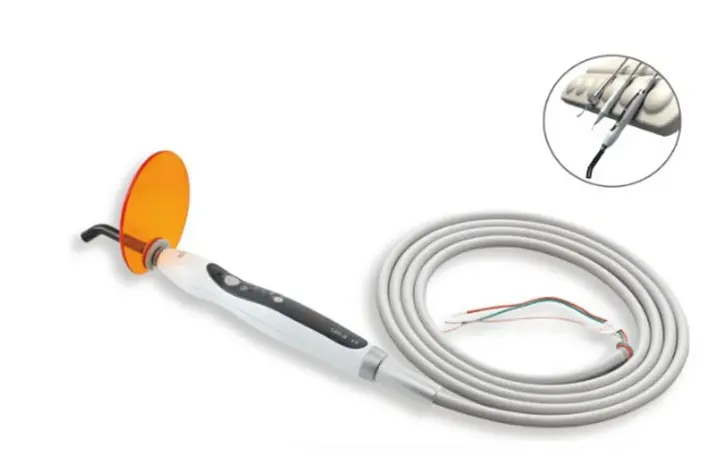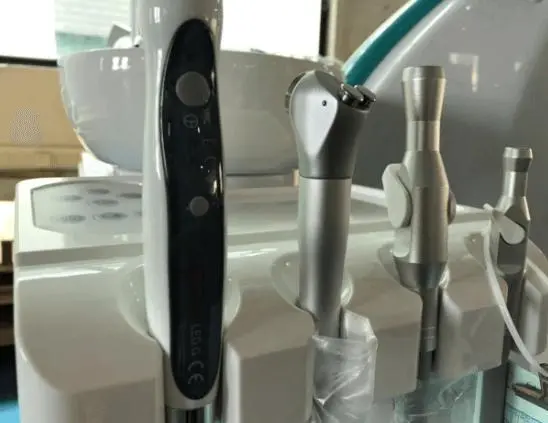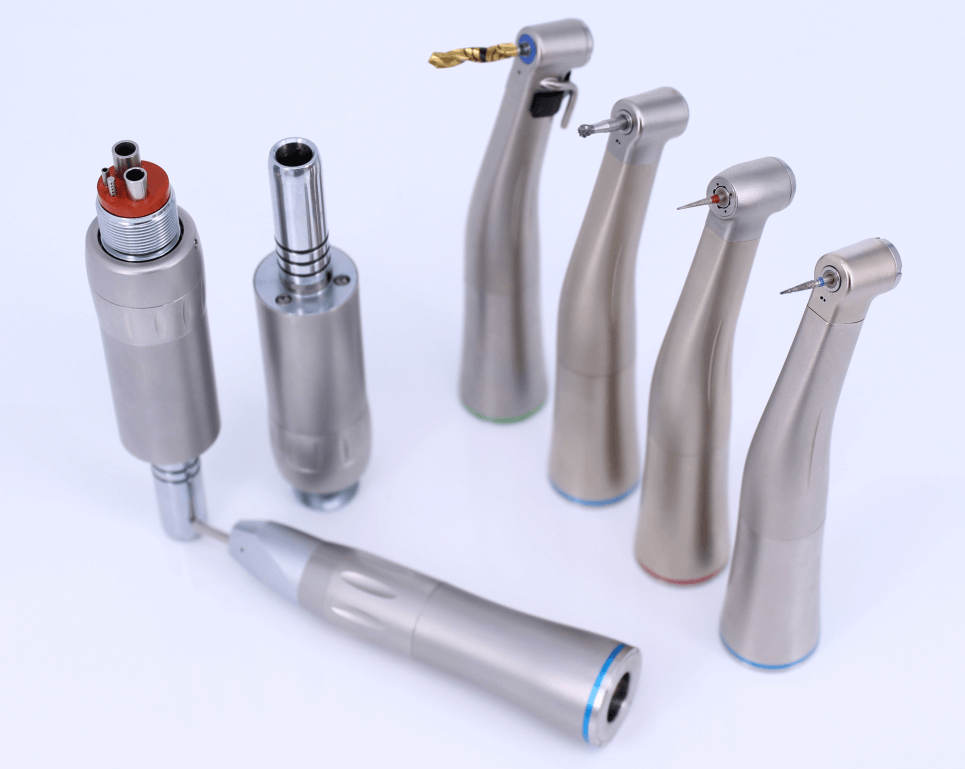Frequently Asked Questions about Dental Curing Light
Looking through the whole dental field, we can find that tooth-filling surgery is one of the most commonly seen surgeries. Dental curing light also become more and more important in dental surgery. However, do you actually know the dental curing light? In this post, the author would guide you to explore the dental curing light.
How Does A Dental Curing Light Work?
The dental curing light is a crucial piece of equipment in tooth filling surgery because it is engineered to harden and cure the dental composite filling material such as composite resins, dental adhesives, and some types of dental types of cement. In the working process, the dental curing light emits a specific wavelength of light that initiates and accelerates a chemical reaction within the dental materials, causing them to harden or set.
Here are the major parts in the curing process:
●Light Source: The curing light typically utilizes a light-emitting diode (LED) or a halogen bulb as its light source. LED lights have become more prevalent due to their efficiency, longer lifespan, and ability to emit specific wavelengths.
●Wavelength Selection: The light emitted by the curing unit is within the blue light spectrum, with a wavelength of approximately 400 to 500 nanometers (nm). This specific wavelength is chosen because it corresponds to the absorption spectrum of the photoinitiator present in the dental materials.
●Photoinitiator: Dental materials like composite resins contain a photoinitiator, a chemical compound sensitive to the selected wavelength of light. When exposed to the curing light's blue light, the photoinitiator absorbs the energy and undergoes a chemical reaction, breaking it down into free radicals.
●Free Radical Polymerization: The free radicals formed from the photoinitiator interact with the monomers present in the dental material. Monomers are the small molecules that form the building blocks of the dental composite. The free radicals initiate a polymerization process, where the monomers link together, forming long chains and converting the initially soft dental material into a hardened, solid state.
●Curing Time: The time required for curing varies depending on the type and thickness of the dental material, as well as the power output of the curing light. Modern curing lights are often designed to deliver high-intensity light output to expedite the curing process, which helps reduce the overall chairside time for the patient.
●Light Curing Mode: Dental curing lights usually offer different modes, such as continuous light or pulse modes. The pulse mode allows for short bursts of light, which helps minimize heat generation during the curing process and reduces the risk of damaging the tooth or causing discomfort to the patient.
●Wavelength Filtering: Some curing lights come with filters that remove harmful wavelengths, like ultraviolet (UV) light, to protect the patient's and dental practitioner's eyes.

Is Dental Curing Light Safe?
If the dentist obey the operation istruction and use the standard dental curing light, the dental curing light is safe.
While dental curing lights are essential tools in modern dentistry, understanding their safety profile is critical for both practitioners and patients. Research published in the Journal of Dental Research (2024) confirms that when used according to manufacturer guidelines, dental curing lights pose minimal risk to patients during routine procedures.
However, potential concerns include:
● Eye Safety Risks: The high-intensity blue light (440-490 nm) emitted by curing lights can potentially cause retinal damage with direct exposure. A 2025 study in Acta Scientific Cancer Biology found that blue light poses the maximum risk for retinal degeneration with prolonged, unprotected exposure.
● Heat Generation: High-intensity curing lights can generate heat during operation. According to clinical research, this heat can potentially cause pulpal damage if exposure times exceed manufacturer recommendations or if the light is positioned too close to the tooth for extended periods.
● Radiation Misconceptions: Unlike dental X-rays, LED curing lights do not emit ionizing radiation. Instead, they produce visible blue light that lacks the energy to damage DNA or penetrate beyond the oral cavity. This distinction is crucial for patient education and consent.
Dental professionals have been using curing lights for many years without significant safety concerns. However, it is essential to follow certain precautions to ensure their safe and effective use:
●Eye Protection: Both the patient and the dental practitioner should wear appropriate eye protection, such as orange-tinted glasses or goggles with built-in filters. This eye protection blocks harmful wavelengths, particularly ultraviolet (UV) light, which can be damaging to the eyes.
●Shielding: The dental practitioner should take care to shield the surrounding oral tissues and other vulnerable areas, such as the patient's lips and skin, from direct exposure to the curing light.
●Proper Use: The curing light should be used as directed by the manufacturer and for the recommended duration of time. Overexposure to the curing light can lead to tissue damage or discomfort for the patient.
●Heat Management: High-intensity curing lights can generate heat during the curing process. Dental professionals should use pulse modes or other techniques to manage heat and prevent potential damage to the tooth's pulp or surrounding tissues.
●Eye Avoidance: The dental practitioner should avoid looking directly at the curing light during use to protect their eyes from exposure to intense light.
●Curing Depth: The curing light's effectiveness decreases as it penetrates deeper into the dental material. To ensure proper curing, dental professionals should be mindful of the material's thickness and consider incremental layering for thicker restorations.
●Regular Maintenance: Routine maintenance and calibration of the curing light are essential to ensure its optimal performance and safety.

Comprehensive Safety Protocols for Dental Curing Light Use
The safety of dental curing lights depends largely on proper usage techniques and protective measures. Implementing these evidence-based protocols significantly reduces any potential risks:
Essential Protective Equipment
● Specialized Protective Eyewear: Both practitioners and patients should wear orange-tinted protective glasses specifically designed to filter blue light wavelengths. These glasses can reduce ocular exposure by up to 98% according to the American Dental Association.
● Light Shields and Barriers: Modern curing lights often feature built-in shields to direct light precisely where needed. Additional barriers can be placed to protect surrounding tissues and minimize scatter.
● Distance Management Tools: Maintaining optimal distance (1-2mm from restoration surface) ensures effective curing while minimizing unnecessary exposure. Some advanced models feature distance indicators to help maintain this safety zone.
Technique Optimization
● Pulse Curing Techniques: Using pulse modes rather than continuous application reduces heat generation while maintaining effective polymerization. Research shows this can reduce pulpal temperature increase by up to 40%.
● Proper Light Positioning: Position the light perpendicular to the restoration surface for maximum efficiency and minimal scatter. This technique reduces exposure time and improves safety margins.
● Regular Equipment Testing: Light output should be measured regularly using a radiometer to ensure optimal performance. Suboptimal output can lead to extended curing times and unnecessary exposure.

How Many Watts Should A Dental Curing Light be?
The wattage of dental curing lights can vary depending on the model and technology used. Typically, dental curing lights have a power output ranging from 5 to 1,500 watts. However, most modern LED curing lights used in dental practices have power outputs in the range of 5 to 100 watts.
In the use of the dental curing light, the dentist should pay attention to the balance of the wattage, because the extremely high power output can generate excessive heat, potentially damaging the tooth or causing discomfort to the patient.
Are Dental Curing Lights Safe During Pregnancy?
Dental care shouldn't be postponed during pregnancy, but understandably, many expectant mothers have questions about procedure safety, including the use of curing lights.
Scientific evidence strongly supports the safety of dental curing lights during pregnancy. The Norwegian Mother and Child Cohort Study, which analyzed data from over 90,000 pregnancies, found no association between dental treatments using curing lights and adverse pregnancy outcomes such as preterm birth or developmental issues.
Several key factors contribute to this safety profile:
● Localized Application: The blue light from dental curing units is strictly contained within the oral cavity and cannot penetrate through body tissues to reach the developing fetus.
● Non-Ionizing Radiation: Unlike X-rays, which are carefully limited during pregnancy, LED curing lights emit only visible light that does not possess the energy to damage DNA or cross the placental barrier.
● Short Exposure Duration: Modern high-intensity LED curing lights require only brief exposure times (typically 10-20 seconds per application), further minimizing any theoretical concerns.
Leading medical and dental organizations, including the American Dental Association and the American Congress of Obstetricians and Gynecologists, affirm that necessary dental procedures using curing lights are safe during all trimesters of pregnancy and should not be unnecessarily postponed.
For additional peace of mind, pregnant patients may request: - Protective eyewear and tissue barriers - Rubber dam isolation to contain the light exposure area - Discussion of alternative materials (self-curing or dual-cure) if concerns persist
Can You Over Cure Dental Composite?
Yes, it is possible to over-cure dental composite. Over-curing occurs when the dental composite material is exposed to the curing light for a longer time than necessary or when the curing light's power output is too high. This can lead to several potential issues:
●Brittle Restoration: Over-curing can cause the composite material to become excessively hard and brittle. A restoration that is too rigid may be more prone to fracture or wear over time.
●Increased Shrinkage: Dental composites undergo a process called polymerization during curing, which involves the contraction of the material as it hardens. Over-curing can lead to increased shrinkage, potentially compromising the bond between the composite and the tooth structure.
●Marginal Leakage: Excessive shrinkage due to over-curing may result in gaps or marginal leakage around the edges of the restoration, allowing bacteria and debris to penetrate and potentially leading to secondary decay.
●Tooth Sensitivity: Over-curing can generate more heat during the curing process, which may irritate the tooth's pulp, leading to post-operative sensitivity for the patient.
●Curing Depth Limitation: Dental curing lights have limited penetration depths for effective curing. Over-curing beyond the recommended depth may not improve the restoration's properties and can potentially harm the tooth's deeper layers.
Frequently Asked Questions About Dental Curing Light Safety
Are dental curing lights dangerous for patients?
When used properly according to manufacturer instructions, dental curing lights pose minimal risk to patients. The primary concerns—eye exposure and heat generation—are effectively managed through standard protective measures such as eye protection, proper technique, and appropriate curing times. Modern LED curing lights have excellent safety profiles compared to older technologies.
Could dental curing lights cause cancer?
No, dental curing lights do not cause cancer. Unlike X-rays or ultraviolet radiation, the visible blue light emitted by dental curing lights does not have sufficient energy to damage DNA or cellular structures. A 2024 review in Acta Scientific Cancer Biology concluded that "curing lights are generally deemed safe for dental procedures when utilized appropriately and following safety guidelines."
How can patients protect themselves during curing light use?
Patients should always wear the protective eyewear provided by their dental professional during procedures involving curing lights. Don't hesitate to ask questions about the safety measures being implemented, and follow your dentist's instructions about keeping still during the curing process to ensure the light remains properly positioned.
What advancements have improved curing light safety?
Modern LED curing lights represent significant safety improvements over earlier technologies. These advancements include precise wavelength targeting, reduced heat generation, shorter curing times, built-in safety features like pulse modes, and improved light guide designs that minimize scatter and maximize efficiency.
Safe Dental Curing Light Usage: Video Demonstration
For a visual demonstration of proper dental curing light usage and safety protocols, watch our comprehensive video guide:
This video covers: - Proper positioning and distance management - Correct use of protective eyewear and barriers - Heat management techniques - Special considerations for sensitive patients - Equipment maintenance for optimal safety
Conclusion
All in all, the dental curing light is essential in the dental surgery and is a great invention in the modern technology era. And, if the dentist correctly use the dental curing light and make a good use of it, it is necessary to have a full understanding about the dental curing light.

